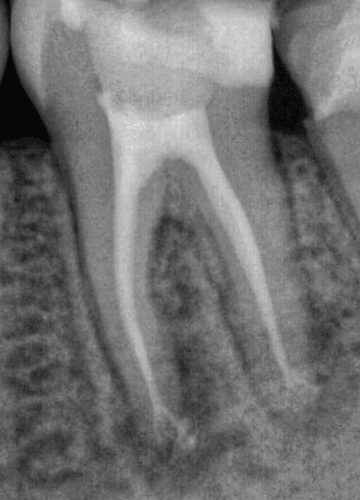What Are Root Canals?

A root canal is the most common endodontic procedure, and one of the most common dental procedures overall. There are more than 15 million root canals performed in the US every year. A root canal can help both diagnose and treat damage within the dental pulp. Damage to the pulp can come from a cracked tooth or dental infection. To prevent further damage to the tooth such as a toothache, bone loss, discoloration and swelling, the patient should get that tooth removed.
The doctor performs a root canal by drilling a hole in the tooth to reach the inside. He then cleans the inside of the tooth is thoroughly and then fills the hole to seal the tooth and prevent bacteria from entering the tooth again. The doctor places a temporary filling as well. This procedure is performed under a local anesthetic in your doctor’s office. The patient will need to make a follow-up appointment to restore the appearance of the tooth with a permanent filling or crown that will help prevent further damage. The success rate for root canal procedures are as high as 95 percent.
Root Canal Retreatment
After a root canal procedure, some teeth may not heal as expected or may suffer from a new infection which will require the doctor to perform another root canal procedure. This often occurs when the initial treatment did not remove all of the affected areas, when infection accumulates again in the treated area, or when the tooth becomes cracked or loose and is exposed to new infection.
Some patients may not experience any symptoms from this condition, while others may experience swelling or pain while chewing. It is important to see your endodontist if you are suffering from any symptoms in a previously treated tooth.
In order to treat a tooth that did not heal properly or has been infected again after a root canal procedure, we will perform a retreatment procedure to ensure that the tooth is thoroughly clear of any decay and is able to function properly. Dr. Garza’s advanced training allows him to do laser root canals for improved results.

Candidates For Root Canal Retreatment
Root canal retreatment is ideal for most patients as an attempt to save the tooth from being extracted. Saving your natural tooth often yields healthier results, and many retreated teeth can function well for years, even for the rest of the patient’s life.
For patients who choose not to undergo retreatment, endodontic surgery may be necessary, which is a much more invasive procedure that involves making an incision to gain access to the tip of the root. Based on your individual case, your endodontist will help decide which treatment option is best for you.
Root Canal Retreatment Procedure
During retreatment, your endodontist will reopen the affected tooth to gain access to the root canal filling. This may require disassembling crowns, posts and other restorative materials in order to reach the root of the tooth. We remove the filling material from the initial procedure and the doctor thoroughly cleans the canals again. Your endodontist will carefully examine the area using magnification and illumination to detect any additional canals or unusual areas.
After the canals are cleaned, the tooth will be filled again with gutta-percha and the canals will be sealed. A temporary filling will be placed in the tooth.
We perform the procedure under local anesthesia, which numbs the affected area and relieves any pain and discomfort. The anesthesia also helps patients relax and relieves any anxieties they may have.
The patient will need a follow-up appointment to permanently restore the tooth with a crown or other material. This helps restore full function to the tooth and protects against future infection or decay.
Laser Root Canal Treatment
Dr, Garza is very experienced having performed over 15,000 Root Canals in his 25-year career. Most Root Canal procedures are completed in 20 minutes or less in our office. The majority of patients report experiencing no pain during or after the procedure. Dr. Garza teaches and uses the PIPs Laser Root Canal Procedure which eliminates (kills) the bacteria within the tooth and helps to ensure that the entire nerve has been removed. We feel our results are better with PIPs Laser treatment.
Root Canal Retreatment Recovery
After retreatment, patients may experience pain, discomfort and tenderness for several days. You should avoid biting and chewing on that side. To relieve symptoms after this procedure, patients can take non-steroidal anti-inflammatory medication such as ibuprofen, Advil, Motrin or aspirin, and can also rinse the mouth with warm salt water three to four times a day.
If symptoms persist or worsen after a few days, please call our office. Patients can return to receive their permanent filling as soon as they wish, and should schedule a routine follow-up visit six months after the procedure.
Root Canal Retreatment Results
This procedure is successful for many patients in thoroughly removing decay and relieving symptoms. Many patients will enjoy permanent results from their root canal retreatment, with the treated tooth functioning properly throughout the patient’s life.
However, there is always a risk that the procedure may be unsuccessful, or that infection will occur again. Retreatment procedures unfortunately have a lower success rate than the initial root canal procedure. You may require extraction or surgery if the procedure us unsuccessful.
Root Canal Retreatment Risks
We consider root canal retreatment to be safe but as with any procedure, there will be risks and complications present. Some of these risks include damage to the tooth and repeated infections.
Patients can minimize these risks by choosing an experienced endodontist to perform your procedure. They can also adhere to the given instructions for before and after the procedure.
SCHEDULE AN APPOINTMENT TODAY OR CALL 480-539-7979 FOR MORE INFORMATION ON OUR SERVICES

